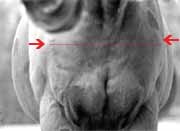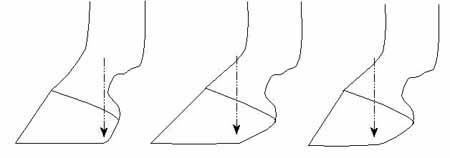 EVALUATING HOOF
BALANCE The previous article introduced you to the effects that hoof imbalances can have on a performance horse. Not all horses have unbalanced hooves, but far too many do. I feel that farriers should be actively correcting those horses to help the horses stay sound longer. This is not to say that your farrier should take sole responsibility for your horse’s soundness. He/she must balance the horse as best as possible—of course, and on an ongoing basis—but it is also the rider's responsibility to ensure that he/she is not contributing to the imbalances with faulty training/riding techniques, rider imbalance, poor saddle fit, dental problems, etc., because how the horse moves is directly related to hoof balance, and vice versa, and not just conformation.
It is possible to ride a horse with this imbalance in such a way that the shoulder lifts temporarily. I have done this myself. But it requires extra time for warmup, and I believe the horse must work harder to remain balanced. I do know that once the same horse has his foot balance corrected, the shoulder stays up, and the horse appears to find his work easier and with a shorter warmup.
• Horses with “underrun” heels have inadequate support at the back of the foot, particularly in combination with long toes. The hoof’s base of support (from the toe to where the heel actually leaves the ground) should be at least partially under the horse’s leg, and ideally supporting the middle of the column of the leg. Underrun heels tend to look like the two feet to the right below, instead of the first foot, on the left.
The “support” heel on the two feet on the right is far in front of the bulbs and column of the leg, forcing the horse to rock back on his heels during motion, resulting in strain up the leg, and contributing to the continuation of poor heel support. Other symptoms may include tightness through the back or hollowness in the loins (underrun heels on hind feet), as well as abscesses of obscure origin, non-specific back pain, and tripping. No matter how much chiropractic, massage, physio or drug therapy you give these horses, the problem recurs unless the feet are also rebalanced because without help it is a vicious circle, and the shape of the foot seldom improves. • If your horse is shod with rockered toes it is very important to avoid an extreme rocker unless you want your horse to snatch up his feet and overload his shoulders. A subtly rockered toe (starting at the first nail holes and gradually increasing until at the toe you can fit one or two credit cards between the ground and the front edge of the shoe) helps the horse break over and facilitates the forward movement of the pastern. Too much rocker will cause the pastern to drop forward slightly during the early part of the forward swing, so the horse “snatches” the leg up. Some time after Cimarron’s initial rebalancing, he was shod by a farrier who gave him noticeably rockered toes. Overnight, Cimarron was moving with a stiffer, hollower back, he couldn't extend his trot, and he was “hen stepping” behind! While a park horse owner might have liked the leg action, I was horrified—my dressage horse's hindquarters were totally disengaged and he was dumping on his forehand! In contrast, a minimally rockered toe really helps him maintain roundness of muscling over the hindquarters. In general, rockered toes are usually a waste of time and effort if the toes are left too long. Recently, various barefoot trims have been advocated. Some of these have merit, and I do prefer to have a horse go barefoot if at all possible. When I first started learning how to help Cimarron, and other horses like him, I was advised that it was easier to make the necessary changes with the help of appropriate shoeing. I believe this is probably still the case if you are dependent on a farrier who will only come out every 4-6 weeks minimum. On the other hand, if you have a more cooperative farrier who will visit every 2-3 weeks, then barefoot trimming is more effective. With everything I have been through with Cimarron, however, I cannot emphasize enough the importance of correct balance in all aspects of the trim, whether shod or barefoot, and this is not something that most people can learn in one or two weekends, as is being advocated by some people right now. It takes time and effort and more time to develop a good eye for these things. As it is, it is disconcerting to me to find so many farriers who don't have this eye either!
We all need to take a more active part in and take more responsibility for our horses’ well-being, and that means learning as much about them as possible. To help you do this, take a half-hour to measure your own horse’s feet to see how balanced they are. Details follow in the next section. Return to Riding Theory
Main Page Return to Hoof Balance
Intro Article Email : rafalet2ride@yahoo.ca | Home | Lusitanos | Equine
Biomechanics & Riding Theory | Last updated December 28, 1999 All rights reserved |

